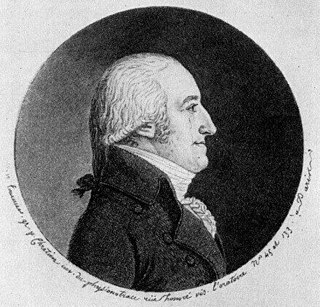
The Danish East India Company refers to two separate Danish-Norwegian chartered companies. The first company operated between 1616 and 1650. The second company existed between 1670 and 1729, however, in 1730 it was re-founded as the Asiatic Company.

William Halling, frequently referred to as Brigadér Halling after 1772, was a Danish nabob and landowner. He owned the Brigadér Halling House in Copenhagen and Dronninglund in Vendsyssel.

Danish Asiatic Company was a Danish trading company established in 1730 to revive Danish-Norwegian trade on the Danish East Indies and China following the closure of the Danish East India Company. It was granted a 40-year monopoly on Danish trade on Asia in 1732 and taken over by the Danish government in 1772. It was headquartered at Asiatisk Plads in Copenhagen. Its former premises are now used by the Ministry of Foreign Affairs.

Cron Printz Christian was the first Chinaman of the Danish Asiatic Company. A former Royal Swedish Navy ship of the line, HSMS Warberg, launched at Karlskrona in 1699, she was one of three Swedish naval ships captured by Tordenskiold at Marstrand in 1719 and subsequently included in the Royal Dano-Norwegian Navy as HDMS Kronprinsen af Danmark. In 1730, she was loaned out to the newly established Danish Asiatic Company for its first expedition to Canton.
Dronning Sophia Magdalena was an East Indiaman of the Danish Asiatic Company, constructed at Asiatisk Plads in 1747. The name was later transferred to another DAC East Indiaman, built Asiatisk Plads in 1762.

Norge was an East Indiaman of the Danish Asiatic Company. She was taken as a prize by HMS Sceptre at the Cape of Good Hope in January 1808.

Arveprinsen af Augustenborg, also referred to as Prinsen(Printzen)af Augustenborg 0r Arve-Prindsen, was an East Indiaman of the Danish Asiatic Company, constructed in Copenhagen in 1789. She sailed on eight expeditions to the Danish India between 1789 and 1807. In January 1808, she was condiscated by the British in the Bay of Bengal.
Dokken was an East Indiaman of the Danish Asiatic Company, built at Andreas Bodenhoff's Dockyard in 1742. She vanished on the way back from her fourth expedition to Tranquebar in Danish India, in 1751, between the Cape of Good Hope and Europe.

HDMS Fridericus Quartus, launched at Royal Danish Naval Dockyards in 1699, was a three-deck, 110-gun ship of the line designed to be the flagship of the Royal Dano-Norwegian Navy. She soon proved difficult to navigate, and unsuited for the shallow Danish waters. She was later used as an East Indiaman, first by the Danish East India Company and then by the Danish Asiatic Company. She was wrecked at Skagen in November 1736, shortly after embarking on her second DAC expedition to Tranquebar. She co-existed with another ship by the same name, a slave ship owned by the Danish West India Company, which wrecked off Costa Rica's coast in 1710.

Pierre Paul Mourier was a Danish Asiatic Company trader who spent 15 years in Canton. He created a Danish-Chinese dictionary of more than 10,000 words. He owned Aagaard from 1787 to 1896.

Vendela was an East Indiaman of the Danish East India Company. In 1732, she was sold to the Danish Asiatic Company.
Prinsesse Louise was an East Indiaman of the Danish Asiatic Company, bought in England in 1738.,
HDMS Dronning Anna Sophia was a ship-of-the-line designed by Ole Judichaer built at Nyholm, Copenhagen for the Royal Danish-Norwegian Navy. She spent the early part of her career in the service of the Danish East India Company, completing four expeditions to Tranquebar between 1722 and the early 1730s. She was decommissioned in 1752.
Prinsesse Wilhelmine Caroline was an East Indiaman of the Danish Asiatic Company.
Kronprinsessen af Danmark ) was an East Indiaman of the Danish Asiatic Company, launched at Asiatisk Plads in 1745. Sje made three expeditions to Tranquebar. She was only able to make it to the Cape of Good Hope on her last homebound voyage but her cargo was later picked up by two other ships.
Elephant, also referred to as Elephanten (definite form: The Elephant) or Elefant(en) (modern spelling) was an East Indiaman of the Danish Asiatic Company, bought in 1745. She sailed on two expeditions to Tranquebar, but wrecked near the Cape of Good Hope in 1750 on her second voyage to India.
Prinsesse Charlotte Amalie was an East Indiaman of the Danish Asiatic Company, bought in England in 1738. She sailed on three expeditions to Tranquebar between 1741 and 1845.
Dronning Caroline Mathilde, later renamed Ganges, following the arrest of her namesake, Princess Caroline-Mathilde of Denmark, was an East Indiaman of the Danish Asiatic Company, built in 1769. She sailed on seven expeditions to the Rast Indies.

Kronprinsessen was a frigate of the Danish Asiatic Company, bought in 1802. During the Napoleonic Wars, in 1808–10, she was loaned to the Royal Danish Navy for use as a station ship. She later sailed on two more expeditions for the Danish Asiatic Company, first to Tranquebar in 1818–20, and then, in 1822–23, to Canton. Theodor Emil Ludvigsen has described the expedition to Canton in his memoirs Erindringer om mine Søreiser og Livs Begivenheder.

Dronning Juliana Maria was a trading ship of the Danish Asiatic Company, bought in Canton in 1790. She was bought as a replacement for another ship of the same name











